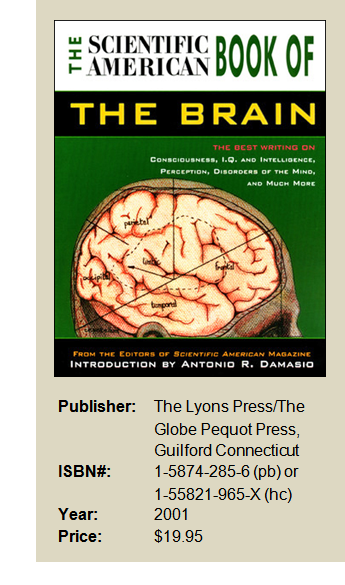 This is an intelligently written and very readable little book on the science of the brain. It serves as a wonderful introduction to neuroscience and makes an important contribution to the understanding of such topics as consciousness, I.Q., intelligence, perception, gender ideation, and neurological diseases. It will serve equally well as an introduction to a neuroscience course or a handbook for the lay person with a need to understand the workings of the brain. This is an intelligently written and very readable little book on the science of the brain. It serves as a wonderful introduction to neuroscience and makes an important contribution to the understanding of such topics as consciousness, I.Q., intelligence, perception, gender ideation, and neurological diseases. It will serve equally well as an introduction to a neuroscience course or a handbook for the lay person with a need to understand the workings of the brain.
This superb text has an introduction written by Dr. Antonio R. Damasio, 32 contributing authors, 340 pages, numerous figures, and photographs including medical imaging studies. In addition to the table of contents and the index, there is one appendix which gives a brief biography of each of the 32 world renowned authors. It is arguably the best little book on one of the most fascinating but hither-to-fore difficult topics, namely the neuroscience behind the workings of the human mind and its diseases.
The book is organized into 6 sections, with each of the 26 chapters written as a stand-alone paper. This allows the reader to start with any topic which particularly interests him or her. Section 1 (Mapping the Brain) has four chapters: The Developing Brain, The Visual Image in Mind and Brain, Brain and Language, and Visualizing the Mind. Section 2 (Reasoning and Intelligence) has three chapters: The General Intelligence Factor, The Genetics of Cognitive Abilities and Disabilities, and Uncommon Talents: Gifted Children, Prodigies, and Savants. Section 3 (Memory and Learning) has five chapters: Working Memory and the Mind, Emotion, Memory and the Brain, Creating False Memories, The Split Brain Revisited, and The Biological Basis of Learning and Individuality. Section 4 (Behavior) has five chapters: Sex Differences in the Brain, Evidence for a Biological Influence in Male Homosexuality, The Biological Evidence Challenged, The Neurobiology of Fear, and Seeking the Criminal Element. Section 5 (Disease of the Brain and Disorder of the Mind) has six chapters: Attention-Deficit Hyperactivity Disorder, Autism, Understanding Parkinson’s Disease, Amyloid Protein and Alzheimer’s Disease, The Neurobiology of Depression, and Manic Depressive Illness and Creativity. Section 6 (Consciousness) has three chapters: The Puzzle of Conscious Experience, Can Science Explain Consciousness? and The Problem of Consciousness.
The book gives a brief description of some of the methods used to test the brain, including molecular biology and genetic tests, PET scans, and MRI. This book is highly recommended for any student of biology or biochemistry and for anyone who knows and perhaps loves (which includes most of us) someone who is afflicted with a mental disorder.
|
